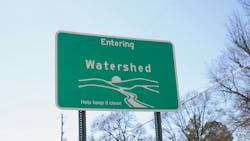Best practices for developing watershed management programs in southern California
Stormwater managers are faced with solving complex and diverse environmental issues. Different watersheds have different waterbodies and supported uses, different upstream landscapes and land uses, different pollutants of concern, and different responsible agencies across jurisdictional boundaries. Under all those differences, stormwater managers are expected to implement control measures that address the most pressing water quality needs. A common planning tool used across Southern California to guide effective and efficient implementation is the development of watershed management programs. Watershed management programs are a combination of rigorous data analysis and modeling, technical engineering and extensive stakeholder coordination to provide a clear pathway towards compliance with stormwater permits for improved water quality and healthier waterways.
The emphasis on collaborative watershed planning across stormwater permittees was driven by the evolution of stormwater permits in Southern California. Alternative compliance pathways are provided through robust planning and programming control measures expected to defensibly achieve water quality goals. Watershed management programs are often established to answer the following questions:
- Where and what are the water quality issues in the watershed?
- What pollutants need to be addressed by municipal permittees?
- What control measures have already been implemented?
- What additional control measures could be implemented?
- How can municipal permittees expect to address their pollutants of concern?
- When will implementation happen?
- How much will the program cost?
- How might the program be funded?
The backbone of these efforts is the reasonable assurance analysis to demonstrate through quantitative justification that identified control measures can meet applicable water quality targets. This is based on combined watershed modeling and control measure modeling to establish (1) how many pollutants need to be reduced and (2) how effective identified control measures are at reducing those pollutants.
Development of watershed management programs in the Ventura, Los Angeles, Orange and San Diego regions has highlighted different approaches and key lessons learned through implementation. The following outlines a framework of four guiding principles towards identifying direct solutions to water quality issues for successful watershed management programs:
- Use the latest and local watershed science and data to refine water quality priorities
- Focus on the agency’s controllable pollutant reductions
- Leverage enhancements to non-structural programs
- Identify feasible structural project opportunities and adaptable implementation pathways
Water quality priorities based on latest science and local data
The first step in developing watershed management programs is to clearly identify where and what the priority water quality issues are to be tackled. In doing so, it is important to establish the most current and site-specific characterization based on available data. This lays the groundwork for the focus of the watershed management program. As it is not possible to monitor everywhere, all the time; therefore, watershed models are an important tool to further characterize ongoing watershed conditions.
Any watershed model should be calibrated to best match simulated values to observed local data. Ideally, a long-term historical dataset that covers a range of weather conditions experienced in the watershed of interest is available for calibration. In the absence of such data, it is recommended to pair the watershed management program with a sufficient monitoring program to support future adaptive management and updates to water quality priorities and modeling.
Pollutant reductions controllable by agencies
Establishing required pollutant reductions is the most influential step in the level of implementation needed to address water quality priorities. It is also the step that highlights a variety of approaches and different decisions or assumptions that can significantly influence the final targets, and therefore the level of effort required to meet water quality goals. Factors that influence required pollutant reductions include what pollutants are considered limiting, where reduction targets are assessed within the watershed, and when numeric targets are assessed across historical or projected climate conditions. Understanding these factors, which significantly influence water quality outcomes and the amount, type and costs of subsequent control measures, is key to defensibly demonstrate the pathway to compliance through the watershed management programs with activities most effectively utilizing agency resources.
What pollutants or conditions are considered limiting expands on the water quality priorities to identify which pollutants require the greatest reductions or which conditions pose the greatest threat. When a limiting pollutant is identified, other pollutants that have similar fates and transport dynamics and can be addressed via similar control measures are expected to be covered by actions identified to address the limiting pollutant. This allows agencies to focus activities on the highest priorities while gaining coverage for other pollutants of concern.
Where targets are assessed, there must be balance between areas small enough to represent waterbodies requiring protection but also large enough to encourage the most effective control measures at repairing the watershed holistically. The assessment locations should also help isolate the responsible agencies participating in the watershed management program. Flowing water does not stop at jurisdictional boundaries, but the watershed model supports allocations to jurisdictional contributions. While watershed management programs encourage a watershed-wide approach and collaboration, agencies must keep in mind where they have opportunities within their control to improve water quality.
When targets are assessed can drastically change required pollutant reductions.
Across watershed management programs developed in Southern California, the period used to evaluate required reductions ranges from long-term, 10-year timeseries, to critical water years, to single critical storms. Each of these result in different answers in terms of not just the baseline required pollutant reductions but also how control measures are expected to perform and how big and how many control measures are needed to meet those reductions. Given weather variability, longer term periods are recommended to plan for variable storm dynamics. These planning efforts are also shifting to incorporate climate change projections into watershed models to best predict future conditions and inform more resilient watershed management programs.
Once water quality priorities and targets are established, agencies must look to what control measures are feasible and cost-effective at achieving the necessary pollutant reductions.
Enhancements to on-structural programs
The first line of defense in reducing pollutants is source control. Depending on pollutants of concern, agencies should first identify what source control activities can take place. The next best control measures are expanding operational programs that help remove pollutants before they can be washed off downstream into stormwater systems and waterbodies. This includes activities that disconnect impervious areas or remove buildup of debris and sediment such as street sweeping or catch basin cleaning. These are often baseline programs already established to meet minimum permit requirements. Within watershed management programs, there are opportunities to identify enhancements beyond minimum permit requirements to optimize pollutant removal from these activities. Non-structural program enhancements should be evaluated in sequence, before downstream structural projects.
Feasible structural projects and adaptable implementation pathways
Identifying project opportunities can be challenging in highly developed areas. Initial screenings prioritize opportunities in public spaces and characterize contributing drainage areas for relative level of treatment. While screening can be automated, it is still important to put “engineering eyes” on project opportunities for preliminary feasibility assessments. This step must also factor in agency preferences or known challenges to pull together a realistic list of opportunities that can move forward into design and construction. All nested impacts (i.e., upstream to downstream influences) of non-structural and structural control measures should be evaluated for a watershed-based pathway satisfying water quality targets.
Ultimately, watershed management programs provide stormwater managers with clearer pathways to address watershed needs. As implementation proceeds, the watershed conditions or control measure opportunities are expected to evolve and change. Therefore, during development of the watershed management program keep in mind dynamic tracking and adaptability moving forward. Modeling tools and metrics used should allow for iterative updates based on changing conditions and progress in the watershed. This tracking and adaptability bring the watershed management program to life as a reliable tool to stormwater managers and ensures continued progress towards clean water.
Brianna Datti
Brianna Datti is the lead engineer of water quality science and regulations at Craftwater Engineering, Inc.








